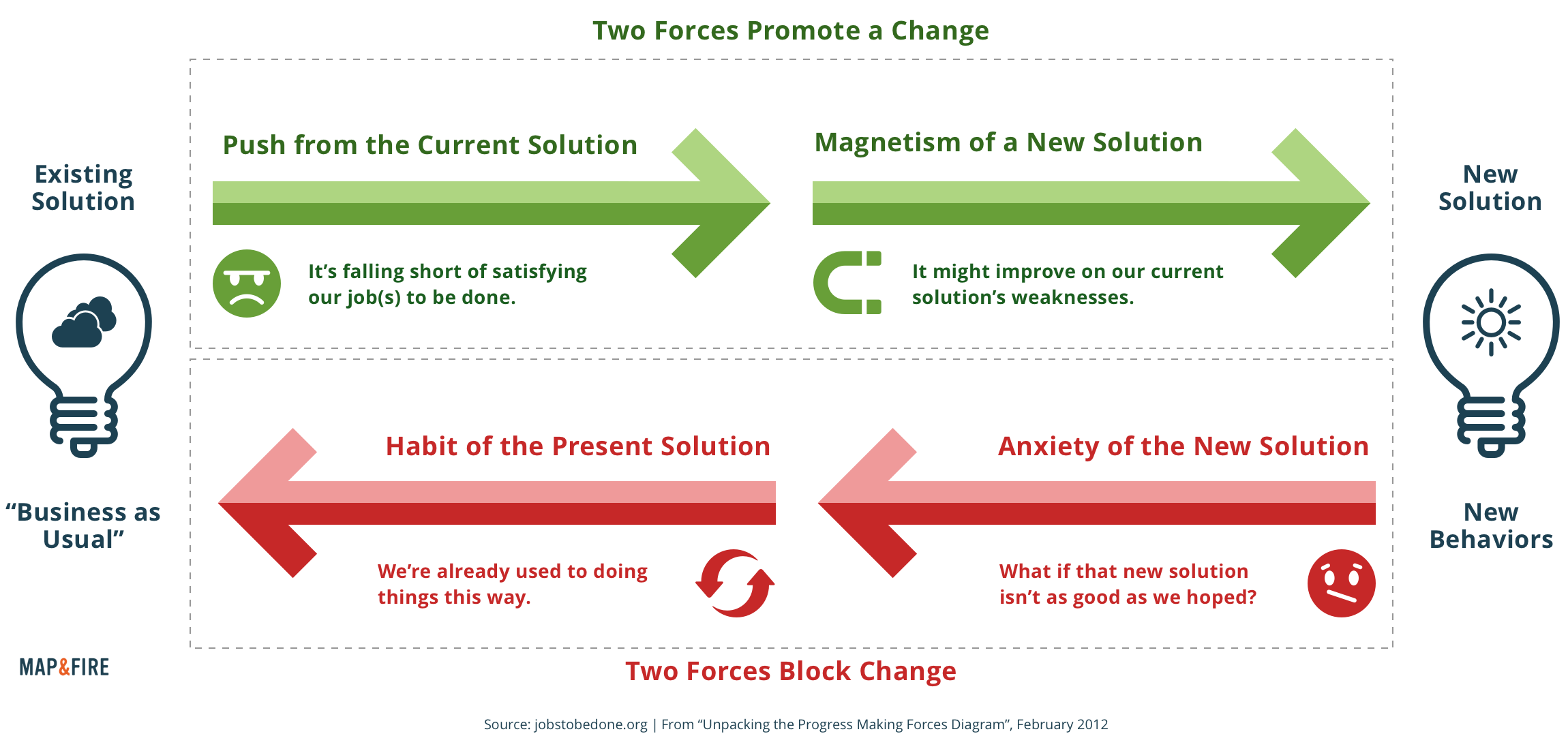
The purpose of your key marketing messages is to describe how your customers’ lives will improve when they engage with your business. It’s an easy concept to articulate, but it contains a key word with a lot of hidden complexity:
Improve.
That one word summarizes an idea that we sometimes forget when it comes to our marketing. And when neglected, it makes our efforts ineffective.
To say that your customers improve, means they have both a current state of being and a desired future state of being.
When your customer first discovers your brand, all they know is their current state. They know they have some pain, need, or desire that’s not totally fulfilled. They want to make an improvement or progress in their life.
It’s that pain, need, or desire that drove them to search for you. There’s something missing within their current state.
That’s the good news — they have an unfulfilled need (aka. a Job to Be Done — learn more in our resource guide).
But here’s the catch.
If your customer’s current need is significant enough to warrant help, then they’ll have, or at least know of, some existing way to address it.
It could be that they use some other product or service. They may also try to solve it themselves.
But the point is, the improvement you’re selling doesn’t exist in a vacuum. Your customers will actively compare it against what they already know. In some cases, they may know that current solution extremely well. It may be deeply ingrained in their lives.
So, your offering needs to be so good that it gets your customer to switch away from what they know right now.
There are some powerful psychological forces at play when it comes to making a switch from a known thing to an unknown thing.
For your marketing to effectively sell an improvement, to sell customers on that switch, you need to understand those forces.
4 Forces That Affect Customers When Switching
The concept of the four forces that affect customer decisions comes from The Rewired Group. Bob Moesta and Chris Spiek defined this concept in connection with the Jobs to Be Done framework to help companies innovate on their products and services.
You can see the relationship of the forces illustrated in this graphic:

The core concept is that there are two forces that promote customers to make a change and two forces that block customers from making a change.
They’re defined as:
Two Forces That Promote Change
1. Force: Push from the Current Solution:
- The current solution falls short of satisfying our needs
2. Force: Magnetism of a New Solution:
- The new solution improves on the weaknesses of our current solution
Two Forces That Block Change
1. Force: Anxiety of the New Solution:
- What if the new solution isn’t as good as we hoped?
2. Force: Habit of the Present Solution:
- We’re already used to how we do things with the current solution
Even one of these on its own could push someone to try something new or make them stay put. That’s why they serve as a critical tool to categorize the different reasons why customers decide to use, or not use, your product or service.
But the other use we’ve found is that they help spark creative ways to define your brand’s marketing messages.
Use The 4 Forces To Guide Your Key Marketing Messages
Again, the purpose of the four forces is to provide a framework for understanding the psychology of customers when considering a change. That insight into how your customers think when deciding to engage with your brand is exactly what makes it valuable as a marketing tool.
To test it out, you can write key messages that either emphasize the positive element of a particular force, or counteract the negative elements of a force:
Two Forces That Promote Change
1. Force: Push from the Current Solution:
- Messaging Strategy: Emphasize shortcomings of what they currently use to show why it’s not satisfying their job sufficiently.
- Example (Lyft): End the hassle of calling a cab and explaining directions to your driver.
2. Force: Magnetism of a New Solution:
- Messaging Strategy: Highlight the key benefits of your Offering (Features, Value Proposition).
- Example (Lyft): Get safe transportation any time, any place, with a couple taps on your phone.
Two Forces That Block Change
1. Force: Anxiety of the New Solution:
- Messaging Strategy: Emphasize how trying your Offering is quick / easy / cheap / guaranteed / etc. to limit their risk and ease their anxiety.
- Example (Lyft): Get your first ride delivered to you within minutes for less than the price of a cab.
2. Force: Habit of the Present Solution:
- Messaging Strategy: Highlight a specific way that your Offering improves on a core feature or attribute of their current solution.
- Example (Lyft): Stop guessing which cab company is the best in your area and use a service that works great everywhere.
You can use this template to test this process out for your own brand:

Once you lay out the foundation of your value proposition, you can use this structure to iterate creatively on the concepts.
Depending on your target market, you may start to see trends around which of combination of forces has the biggest impact for your brand. You may also want to create specific landing pages that target customers affected by one particular force more than the others.
Through testing, you can start to pinpoint which angle is most effective when it comes to getting your customers to engage and make a switch.
Message To Your Customers’ Motivations and Desired Outcomes
Making a change is never easy. For someone to commit the energy and resources to switch to something new, that new thing has to be really good.
Using the four forces framework helps us break down these switching challenges into parts that are easier to understand and address. The more you know about how your customers think and what motivates them, the better you’ll get at pulling the right mental levers to get them to take action.
The important thing to keep in mind is that your customers want to improve their lives. The four forces help you find the right position for your brand as the solution to get them there.

Get Help Messaging Effectively To Your Customers
If you’re ready to build stronger connections with your customers, reach out for a free consultation. We’ll help you transform your best business thinking into an actionable, shareable, growth-oriented guide. Click below to learn more about the Brand Guidebook process.

